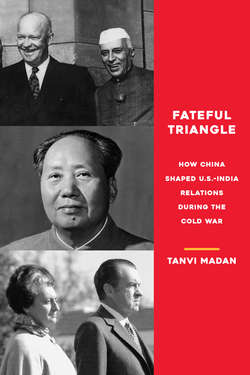Читать книгу Fateful Triangle - Tanvi Madan - Страница 32
3 The Pandit and the President (1956–1958)
ОглавлениеIt speaks much for the latent strength of Indo-US friendship that the stresses and strains of the international crises in 1958 and storms in [the] UN did not cause any basic adverse effects on Indo-US friendly relations in spite of the known divergencies [sic] in outlook. The tendencies in the past which have cast considerable doubts and suspicions on the ability of the “two largest democracies in the world” to co-operate were not only kept in check but were materially reduced in influence.
—Annual Political Report for 1958 from Embassy of India, Washington, DC1
It was also dawning on America that in a war of ideas or ideologies, India was the strongest “ally” in a strategic region of the world not because India had announced this alliance, nor that India had signed any treaty, but that India existed and continued to grow as a thriving Democratic State.
—Annual Political Report for 1959 from Embassy of India, Washington, DC2
By the time Nehru traveled to the US in December 1956, there was greater convergence or at least parallelism in American and Indian views than there had ever been. And between 1956 and 1962, Delhi’s perception of China and its policy toward that country would move closer to those of the US. There were changes in Washington too—not on the question of whether China was a threat, but in the kind of threat that it posed and in the means considered best to tackle it. This US-India convergence on China not only implicitly eased the strains between the two democracies but also explicitly brought them together.
Washington had growing concerns about both the security threat and the ideological challenge that China posed. Likewise, the Indian leadership increasingly saw China as a traditional security threat as well as a symbolic one. Moreover, the US and India agreed on what was required to contain and confront such a threat: close partnership with each other, and the strengthening of India’s development effort and eventually its defense apparatus.
Between 1956 and 1958, Eisenhower came around in part to Nehru’s view of the threat from communism and China. His administration worried that along with communist infiltration of individuals, the infiltration of ideas and influence could be threatening. Washington watched the battlefield for hearts, minds, and stomachs unfold beyond Europe through a Cold War lens. It would be a victory for communism if Soviet-backed China succeeded while India failed economically. But if the US helped India win the development race versus China, it could demonstrate to the uncommitted world that democracy and development could coexist and thrive.
Simultaneously, Nehru started to worry about the threat of the infiltration of individuals and influence from China. There was growing concern about China’s attitude toward the Sino-Indian border, Chinese behavior in Tibet, and Beijing’s increasing interactions with India’s neighbors. Delhi had growing doubts about China’s commitment to peaceful coexistence and noninterference. Furthermore, Nehru was anxious that China might demonstrate that its approach—rather than democratic India’s—was more successful at delivering the goods to its people. Between 1956 and 1958, his government dealt with charges of complacency and stagnation while China seemed to thrive next door and communism established an official foothold within India. Nehru’s government had to kick-start the economy, but this task was near impossible without external assistance, especially from the US.
The US and India now needed each other to play a role in their China strategies. This newfound importance was accompanied by a greater tolerance of the other’s approach. There was also a reduced emphasis on differences and—where they continued to exist—a better way of handling disagreements. For India, this stood in sharp contrast to the way communist countries seemed to handle disagreements.
This chapter, covering the period from 1956 to 1958, first considers the reasons for the shift in the Eisenhower administration’s approach toward the uncommitted world, and its changing perception of India in relation to China. It then outlines how the idea of the development race between China and India took hold in American and Indian minds and facilitated the American desire to aid India. The next section considers why Indian views of China—and the US in relation to it—changed. It lays out how China’s bilateral and subcontinental behavior raised Indian concerns, and how Indian policymakers found their approach to global issues diverging from that of China and the communist world more broadly. The chapter then looks at how converging American and Indian perceptions of China, as well as India’s stepping back from an intermediary role between China and the US, created the conditions for Delhi and Washington to manage their differences more effectively.
